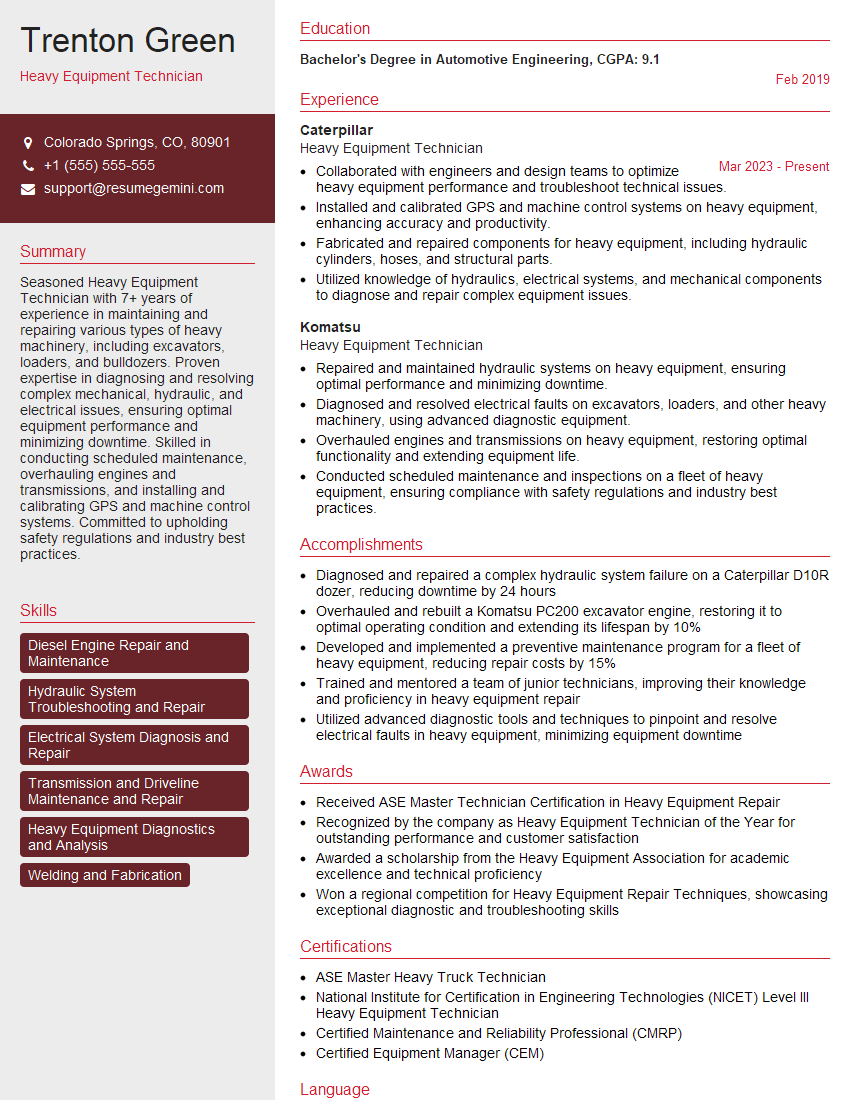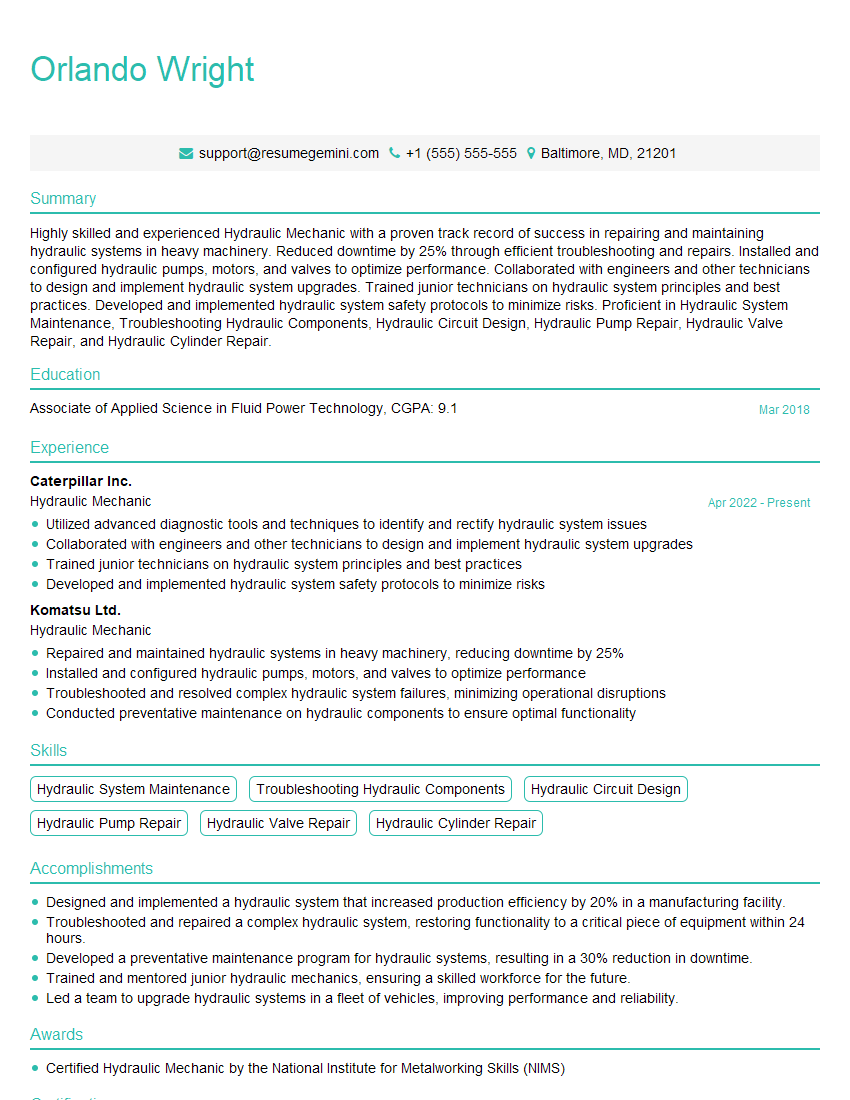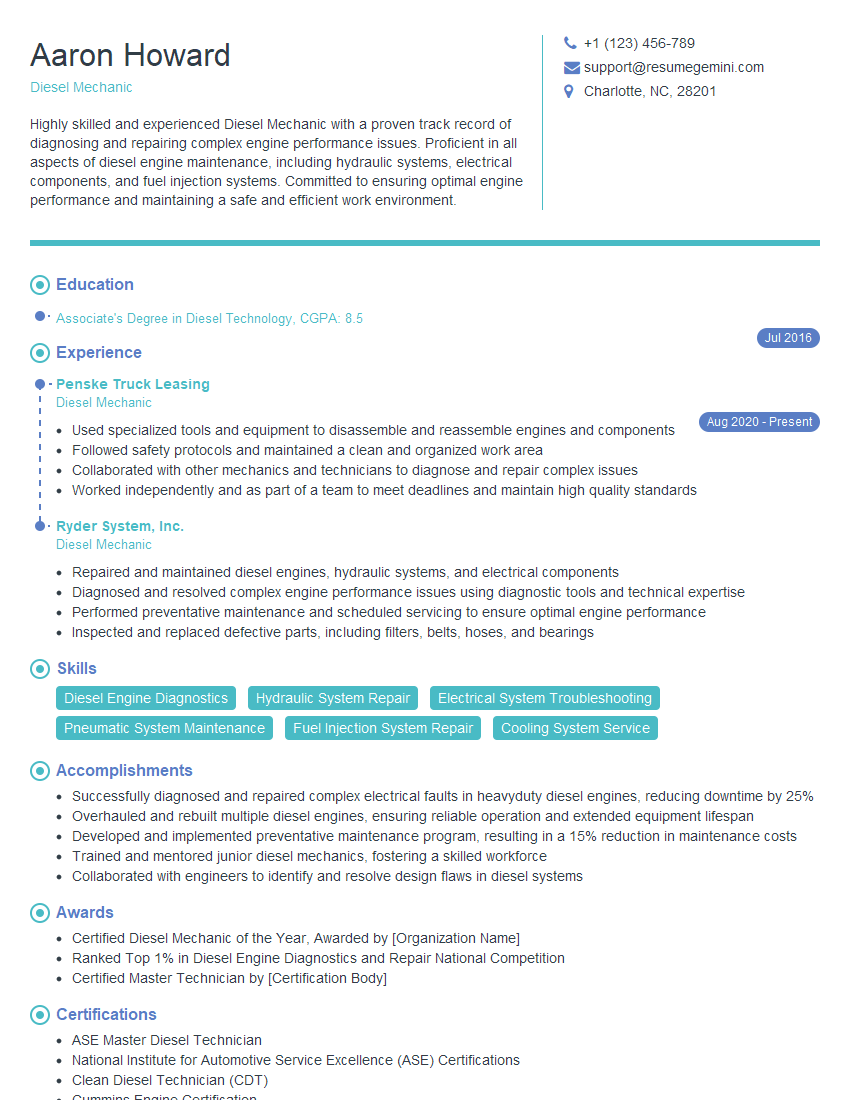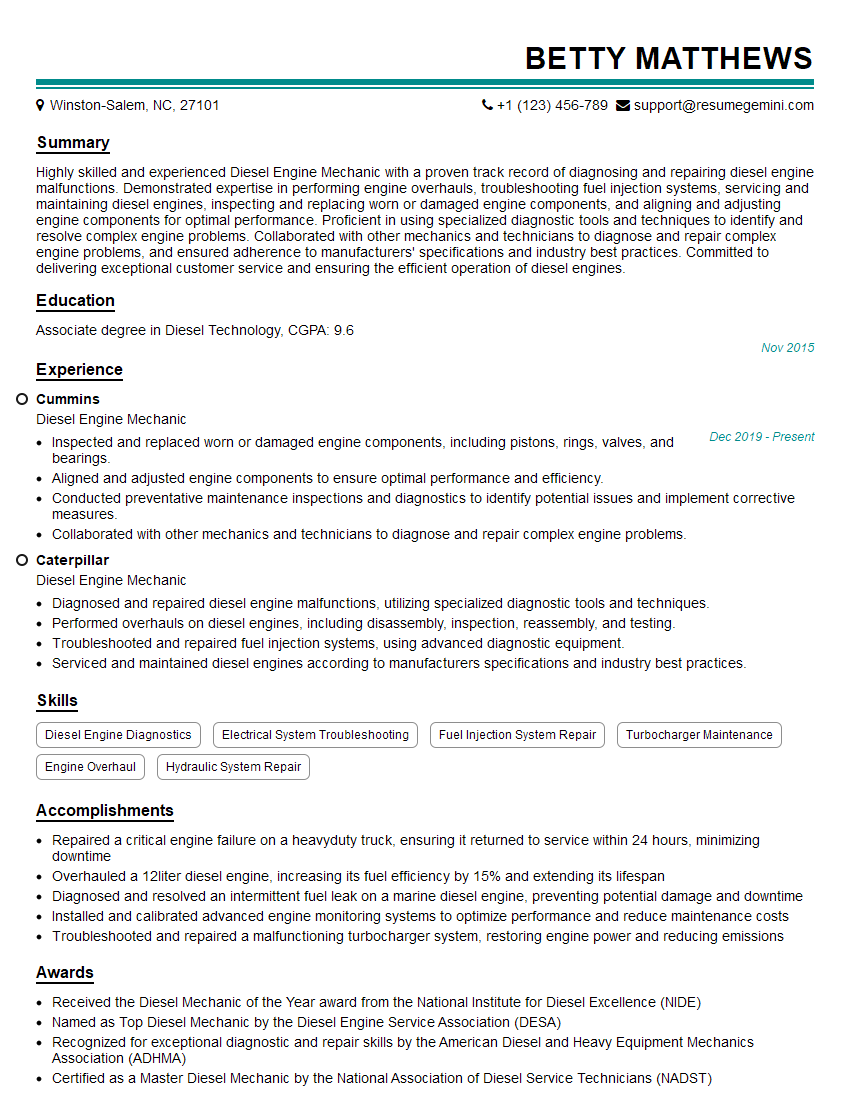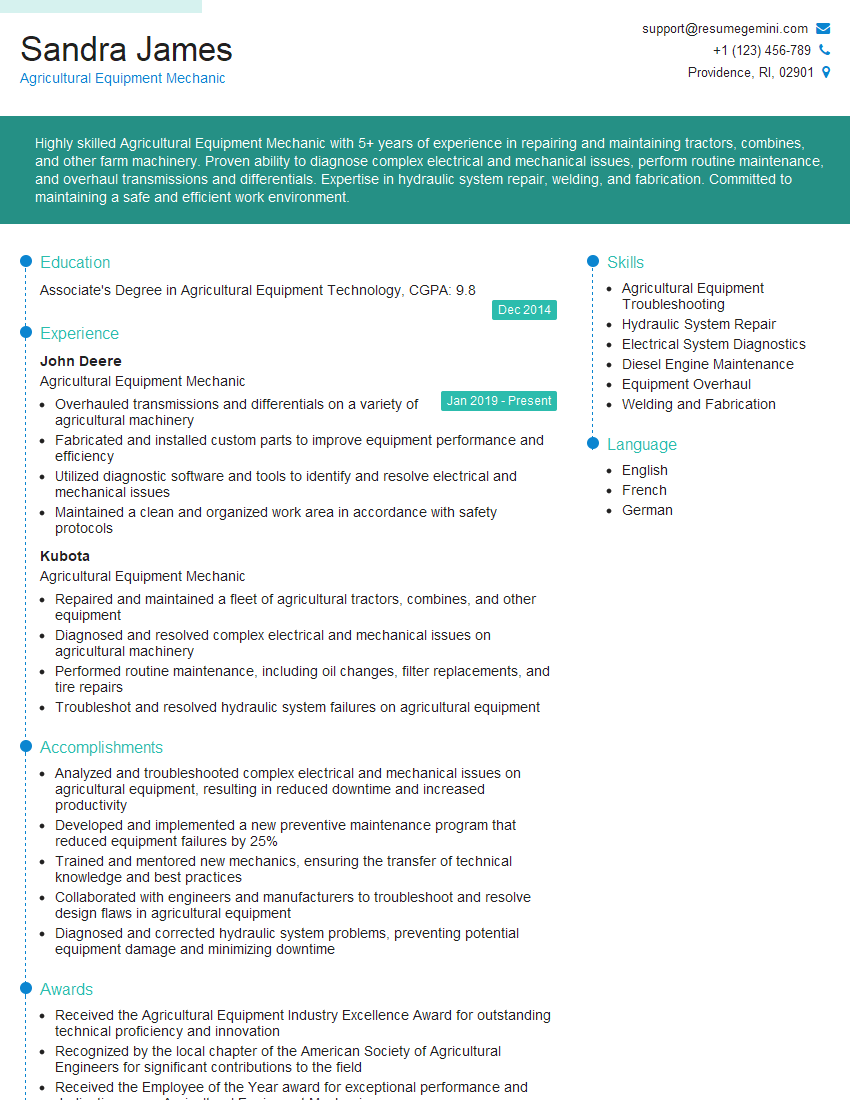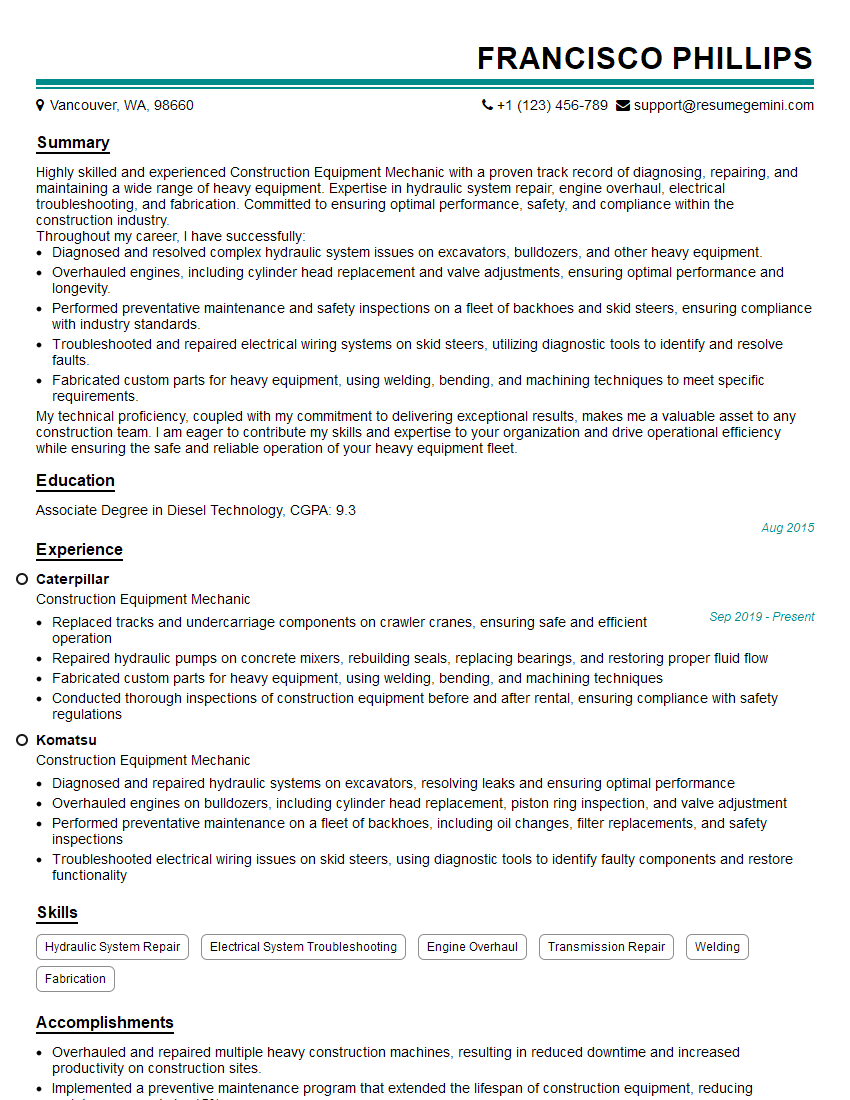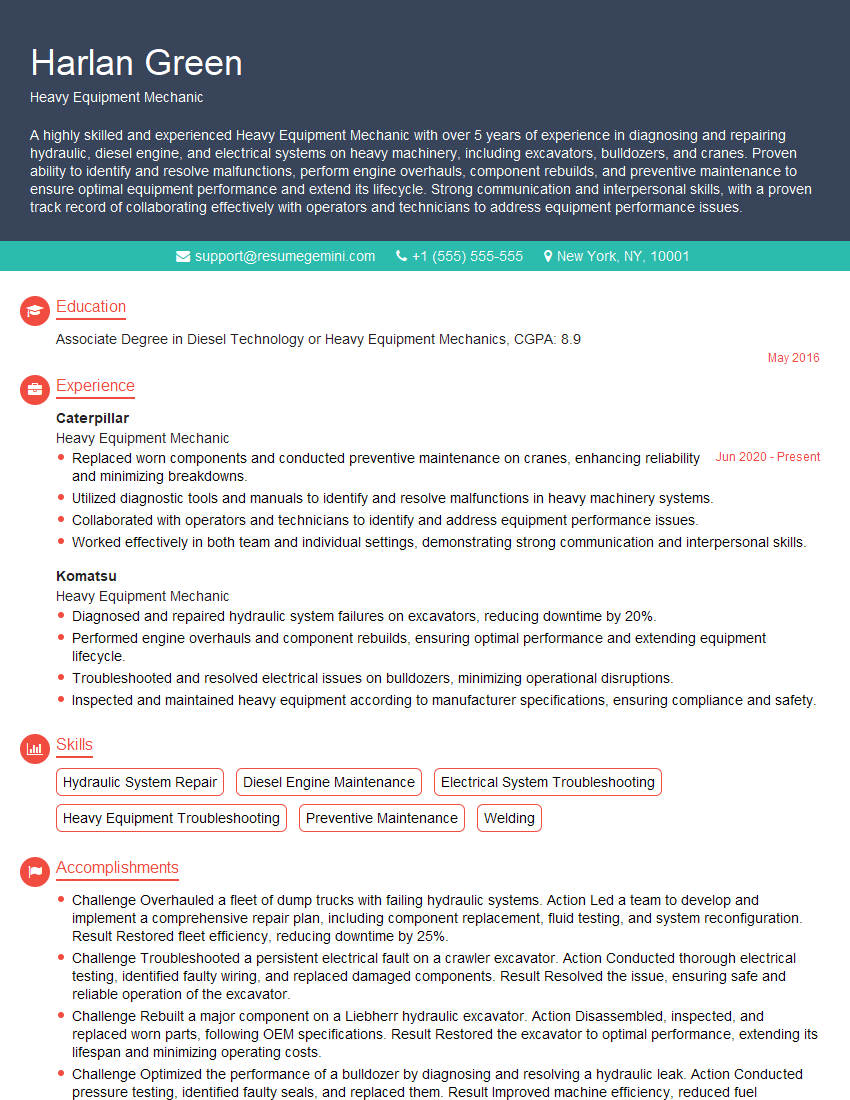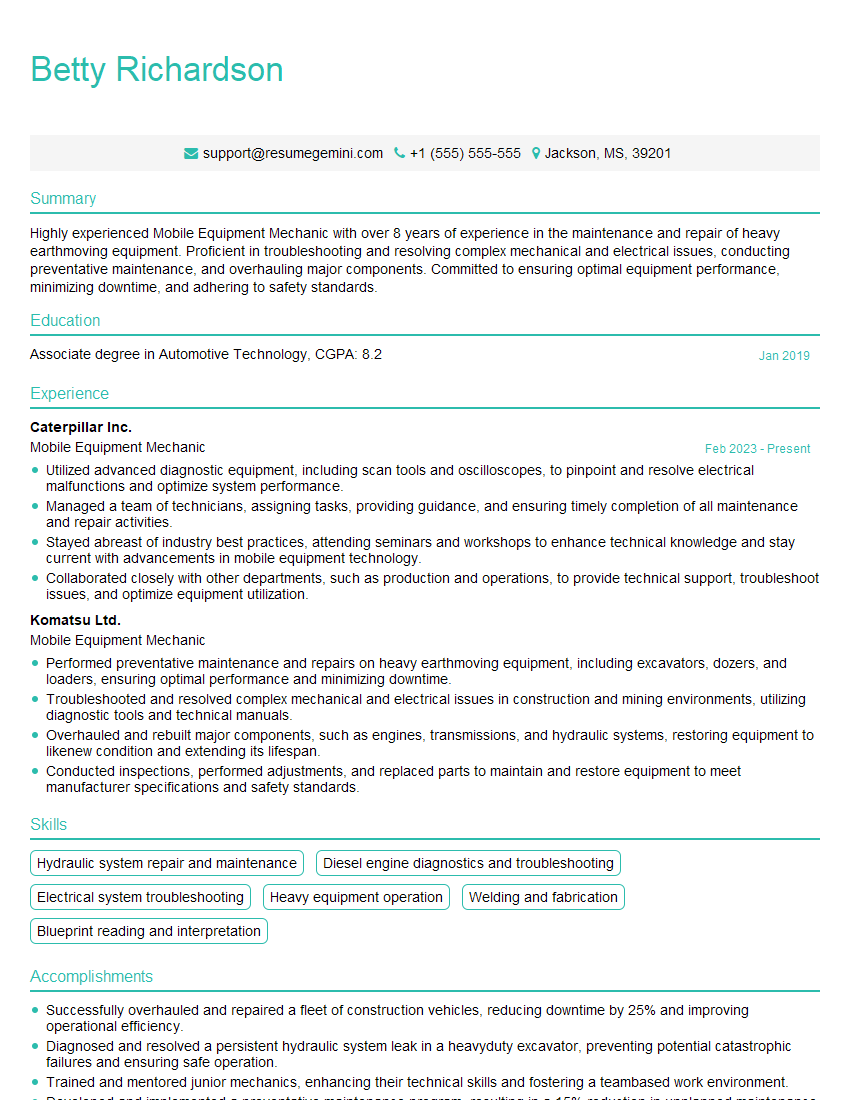Interviews are more than just a Q&A session—they’re a chance to prove your worth. This blog dives into essential Heavy Equipment Maintenance and Repair interview questions and expert tips to help you align your answers with what hiring managers are looking for. Start preparing to shine!
Questions Asked in Heavy Equipment Maintenance and Repair Interview
Q 1. Describe your experience diagnosing and repairing hydraulic systems in heavy equipment.
Diagnosing and repairing hydraulic systems in heavy equipment requires a systematic approach. It’s like detective work, tracing the problem from its symptoms to its root cause. I start by observing the malfunction – is there a leak, a lack of movement, or unusual noise? Then, I utilize diagnostic tools such as pressure gauges, flow meters, and hydraulic testers to pinpoint the issue. For example, a slow-moving bucket could indicate low hydraulic fluid pressure, a faulty pump, or a blocked filter. A leak, on the other hand, might point to a damaged hose, seal, or cylinder. Once the faulty component is identified, the repair process involves replacing or repairing that part, carefully following the manufacturer’s specifications, ensuring the system is bled properly and thoroughly tested for leaks and functionality before returning the equipment to service. I’ve successfully repaired systems in excavators, loaders, and bulldozers, dealing with issues ranging from simple hose replacements to complex valve overhauls. My experience includes working with various hydraulic components, such as pumps, valves, actuators, and cylinders, across a range of heavy equipment brands.
Q 2. Explain the process of troubleshooting a diesel engine malfunction.
Troubleshooting a diesel engine malfunction is a methodical process. I begin with a visual inspection, checking for obvious issues like fuel leaks, loose connections, or damaged components. Then, I use diagnostic tools like code readers and pressure gauges to gather data. A low compression reading, for example, could point to worn piston rings or a valve problem. High exhaust temperature might signal a problem with fuel injection or turbocharger. For example, I once encountered a heavy-duty truck with a misfiring engine. By using a code reader, I identified a faulty injector. Replacing the injector resolved the issue, a situation that would have caused extensive damage if left unresolved. I systematically check fuel delivery, air intake, compression, and exhaust systems, paying attention to the engine’s performance characteristics, sounds, and smells. Based on the collected information, I make a diagnosis and implement the appropriate repair strategy. This approach often involves consulting service manuals, schematics, and diagnostic software relevant to the specific engine model.
Q 3. What are the common causes of overheating in heavy equipment engines?
Overheating in heavy equipment engines stems from a few primary sources. Think of it like a car on a hot summer day – if the cooling system isn’t working efficiently, the engine overheats. Insufficient coolant, a clogged radiator, a malfunctioning thermostat, or a faulty water pump are all common culprits. Low coolant levels can be due to leaks, while a clogged radiator restricts coolant flow, preventing efficient heat dissipation. A faulty thermostat may fail to open, preventing coolant circulation, while a failing water pump cannot effectively circulate the coolant. Beyond the cooling system, inadequate lubrication can lead to increased friction and heat generation. Finally, issues with the engine itself – like a faulty head gasket – can allow coolant to escape or mix with oil, resulting in overheating. Regularly checking coolant levels, performing radiator flushes, and keeping an eye on engine temperature are crucial for preventative maintenance.
Q 4. How do you perform preventative maintenance on a bulldozer?
Preventative maintenance on a bulldozer is crucial for extending its lifespan and preventing costly repairs. My approach is systematic and follows a checklist. This includes regular inspections of all fluid levels (engine oil, hydraulic oil, transmission fluid, coolant), checking tire pressure, and lubricating moving parts. I inspect the undercarriage for wear and tear, looking for loose tracks, damaged rollers, or worn sprockets. I also carefully examine the blade and its connections, checking for any signs of damage or wear. I examine the engine compartment for leaks, loose belts or hoses, and corrosion. Additionally, I carry out regular filter replacements (fuel, air, hydraulic) and perform scheduled service tasks like changing engine oil and filters according to the manufacturer’s recommendations. These scheduled tasks aren’t just about replacing parts; they’re about early detection of potential problems and avoiding costly breakdowns. For instance, timely oil changes prevent sludge buildup, which extends the engine’s life. I also document all maintenance activities meticulously. The preventative maintenance routine is adapted based on the operating conditions and the bulldozer’s age.
Q 5. Describe your experience with different types of heavy equipment transmissions.
My experience encompasses various heavy equipment transmissions, including manual, automatic, and powershift transmissions. Manual transmissions, common in older equipment, require skilled operation and regular maintenance to prevent wear and tear. Automatic transmissions use torque converters to transfer power smoothly, offering ease of operation but needing careful monitoring of fluid levels and condition. Powershift transmissions, often found in larger equipment, are highly efficient but require precise adjustments and specialized knowledge for repairs. I’ve worked on transmissions from various manufacturers, troubleshooting issues like gear slippage, hard shifting, and fluid leaks. For example, I once diagnosed a problem with a powershift transmission on an excavator where the machine wouldn’t shift properly under load. Through careful inspection and diagnosis I identified a faulty clutch pack and resolved the problem by replacing it. The key is to understand the specific characteristics and maintenance requirements of each transmission type.
Q 6. How familiar are you with different types of heavy equipment brakes?
I’m familiar with various types of heavy equipment brakes, including disc brakes, drum brakes, and wet brakes. Disc brakes, similar to those in cars but larger and more robust, are common in many modern machines and provide excellent stopping power. Drum brakes, while more common in older equipment, utilize friction between brake shoes and a rotating drum. Wet brakes, often used in transmissions and other hydraulic systems, operate submerged in fluid. Each type has its own strengths and weaknesses and requires different maintenance procedures. For instance, disc brakes require regular inspection of the pads and rotors for wear, while drum brakes may need adjustments to maintain effective braking. Wet brakes necessitate monitoring of fluid levels and cleanliness. I’ve encountered problems with brake systems including brake fade, leaking seals, and worn components, resolving these issues by replacing parts or adjusting systems to achieve optimal braking performance. Safety is paramount when working with brakes, and I always ensure the equipment is properly secured and any necessary safety precautions are in place before carrying out any repairs or maintenance.
Q 7. What safety procedures do you follow when working on heavy equipment?
Safety is my top priority when working on heavy equipment. Before starting any work, I always ensure the machine is properly secured, using wheel chocks, parking brakes, and potentially engine shutdown. I thoroughly inspect the area for potential hazards, such as uneven ground or electrical lines, before beginning work. I use appropriate personal protective equipment (PPE), including safety glasses, gloves, hard hats, and steel-toed boots, as needed by the specific task. I understand and follow lock-out/tag-out procedures to prevent accidental start-ups. I’m trained in the safe handling and use of tools and equipment. Furthermore, I’m familiar with the specific hazards associated with hydraulic systems, electrical systems, and diesel engines. I always work in accordance with all relevant safety regulations and company policies. Regular safety training keeps my skills and knowledge current, ensuring I always maintain a high level of safety awareness.
Q 8. How do you interpret and utilize heavy equipment repair manuals?
Heavy equipment repair manuals are my bible. They’re more than just diagrams; they’re the roadmap to troubleshooting and fixing complex machinery. I approach them systematically. First, I identify the specific model and serial number of the equipment to ensure I’m using the correct manual. Then, I pinpoint the problem—is it a hydraulic leak? Engine malfunction? Electrical fault?—and use the manual’s index, diagrams, and troubleshooting sections to pinpoint the likely cause. For example, if I’m dealing with a hydraulic leak on an excavator, I’ll look for diagrams of the hydraulic system, check for pressure readings specified in the manual, and follow the troubleshooting steps for low hydraulic pressure or leaks. The manuals often have detailed exploded views showing the component relationships, which makes locating parts and understanding their function much easier. I always cross-reference information from different sections to get a holistic understanding before starting any repair.
Beyond the troubleshooting, the manual is crucial for proper repair procedures. It outlines the necessary steps, tools, and torque specifications to ensure the repair is done correctly and safely. Ignoring these specifications can lead to further damage or safety hazards. I treat the manual as a living document, marking pages, adding notes, and updating it as I encounter new challenges and solutions—turning it into a personalized resource.
Q 9. Explain your understanding of different types of lubricants and their applications.
Lubricants are the lifeblood of heavy equipment. Choosing the wrong one can lead to catastrophic failure. My understanding encompasses different types, including:
- Engine Oils: These are critical for engine lubrication, reducing friction and wear. The choice depends on the engine type (diesel, gasoline), operating conditions (temperature, load), and manufacturer recommendations (API classifications like CJ-4 or CI-4 for diesels). I always consider factors like viscosity (SAE grades) to ensure proper lubrication at different temperatures.
- Hydraulic Oils: These are critical for hydraulic systems, transmitting power and lubricating components. These oils must have the right viscosity and anti-wear properties to prevent component failure. Common types include AW (anti-wear) and HV (high viscosity) hydraulic oils, with specific requirements based on equipment and conditions.
- Gear Oils: Used in gearboxes and differentials, these oils withstand high pressures and loads. EP (extreme pressure) gear oils are often necessary for heavy-duty applications to handle shock loads.
- Greases: Used for lubrication in bearings, joints, and other components where oil won’t stay in place. They’re categorized by consistency (NLGI grades) and type (lithium-based, calcium-based, etc.), each suited for different applications and operating temperatures.
Choosing the right lubricant requires careful consideration of the manufacturer’s recommendations and the operating environment. Using the incorrect lubricant can lead to premature wear, component failure, and costly repairs. For example, using a grease with too high a viscosity in a bearing will hinder its operation, while using too low a viscosity oil in a gearbox can lead to excessive wear.
Q 10. What are your experience with welding and fabrication related to heavy equipment repairs?
Welding and fabrication are essential skills in heavy equipment repair. I’m proficient in various welding techniques, including stick, MIG, and TIG welding. My experience extends to repairing structural components, such as bucket teeth, booms, and frames. I understand the importance of using the correct filler metal and welding techniques to ensure the repair is strong, durable, and meets the original material’s specifications. For example, I’ve repaired severely damaged excavator arms using a combination of MIG welding and grinding to restore strength and integrity, always ensuring proper pre- and post-weld preparation. Fabrication skills are equally important, allowing me to create custom parts or repair components that aren’t readily available. This includes cutting, shaping, and assembling metal components to replace damaged parts or even fabricate complete sections if needed.
I prioritize safety above all else, using appropriate personal protective equipment (PPE) including welding helmets, gloves, and protective clothing. It’s not only about making the weld but also about doing it safely and to the required quality standard. For instance, ensuring proper penetration and avoiding weld defects is crucial for preventing future failures. The fabrication part ensures I can create custom solutions when standard parts are unavailable, saving both time and cost.
Q 11. How proficient are you in using diagnostic tools for heavy equipment?
Proficiency with diagnostic tools is paramount. I’m experienced with various diagnostic tools, including:
- Engine diagnostic scanners: These help identify engine trouble codes (DTCs), monitor sensor readings, and analyze engine performance data. This allows me to efficiently diagnose problems like fuel injection issues, sensor malfunctions, and other engine-related problems.
- Hydraulic system analyzers: These measure hydraulic pressures, flows, and temperatures, helping identify leaks, flow restrictions, and other hydraulic system problems. They help me isolate the source of issues within complex hydraulic circuits.
- Electrical diagnostic tools: These include multimeters, oscilloscopes, and wiring diagrams to diagnose electrical faults in the equipment. This is crucial for troubleshooting issues in lighting systems, control circuits, and other electrical components. I can trace short circuits, open circuits, and ensure proper voltage and current levels.
I also understand the importance of interpreting data from the diagnostic tools. A simple error code might point to several possible issues. It is critical to gather comprehensive data, understand the systems’ interdependency and use the information provided by the tool in conjunction with the repair manual to arrive at the right diagnosis and implement the best solution. For example, a low hydraulic pressure could be caused by a leaking pump, a clogged filter, or even a faulty pressure relief valve; the diagnostic tools help pinpoint the exact cause.
Q 12. Describe your experience working with electrical systems in heavy equipment.
Working with electrical systems in heavy equipment requires a thorough understanding of both low-voltage and high-voltage circuits. I’m experienced in troubleshooting and repairing various electrical components, including:
- Alternators and starters: I can diagnose charging system problems, test alternators and starters, and perform necessary repairs or replacements.
- Wiring harnesses and connectors: I can trace and repair damaged wiring, replace connectors, and ensure proper grounding. This is critical for preventing short circuits and ensuring reliable operation of the various systems.
- Control systems: This includes working with electronic control units (ECUs), sensors, and actuators to diagnose and repair issues in sophisticated control systems. Understanding how the electrical and hydraulic systems integrate is very important.
- Lighting and warning systems: I can diagnose and repair problems in vehicle lighting, backup alarms, and other warning systems, which are crucial for safety.
Safety is paramount when working with electrical systems. I always use appropriate safety measures, including lockout/tagout procedures to prevent accidental energization. I rely on schematics, wiring diagrams, and testing equipment to ensure proper functionality and prevent electrical shocks.
Q 13. How do you handle emergency repairs on a job site?
Emergency repairs on a job site demand quick thinking and effective problem-solving. My approach is systematic:
- Assess the situation: Determine the nature and severity of the problem. Is it a safety hazard? Will it cause significant downtime? This informs how quickly and what measures are needed to restore functionality.
- Prioritize safety: Ensure the safety of personnel and the equipment before attempting any repairs. This might involve securing the area, using appropriate PPE, and shutting down power sources if necessary.
- Implement a temporary fix: Focus on restoring the equipment to a minimally operational state to avoid significant downtime. This might involve a temporary repair (e.g., using a makeshift patch to seal a hydraulic leak) until a permanent repair can be made.
- Document the issue: Take photos, record observations, and gather data to facilitate the permanent repair later. This is crucial for properly understanding the repair.
- Plan the permanent repair: Once the immediate crisis is averted, focus on procuring the needed parts and scheduling the permanent repair, making sure to obtain any necessary approvals from relevant supervisors.
I once had to deal with a broken hydraulic cylinder on a bulldozer in a remote location. I managed to fabricate a temporary support brace to allow the operator to complete the immediate task, thereby avoiding a costly shutdown. I then documented the issue and arranged for the delivery of a replacement cylinder.
Q 14. How do you prioritize multiple maintenance tasks?
Prioritizing maintenance tasks involves a combination of factors. I typically use a combination of methods:
- Urgency and Criticality: Tasks that pose safety risks or significant downtime are prioritized higher. For instance, a faulty brake system would take precedence over a minor cosmetic issue.
- Preventive vs. Corrective Maintenance: Preventive maintenance (regular servicing, lubrication) prevents major problems later on. However, critical corrective maintenance (fixing existing malfunctions) often takes precedence.
- Impact on Operations: Tasks that affect the overall productivity of the equipment are prioritized higher. For example, a malfunctioning engine needs immediate attention because it stops the operation entirely.
- Cost and Time Considerations: Some tasks may require specialized tools or parts, pushing their timing. A cost-benefit analysis may also determine priority.
I often use a simple matrix, evaluating each task based on urgency and impact. This helps me visualize the workload and plan the repairs accordingly. Proper planning and communication are critical so the job is done with minimum delays.
Q 15. Explain your experience with different types of engine fuel systems.
My experience encompasses a wide range of engine fuel systems, from the simpler mechanical systems found in older equipment to the sophisticated electronic controlled systems in modern machines. I’ve worked extensively with both diesel and gasoline engines. This includes:
- Mechanical Fuel Systems: These involve fuel pumps, injectors, and carburetors. Troubleshooting issues in these systems often requires a deep understanding of fuel pressure regulation, injector timing, and carburetor adjustments. I’ve successfully diagnosed and repaired numerous fuel leaks, pressure issues, and carb malfunctions, restoring optimal engine performance. For example, I once diagnosed a fuel starvation issue on an excavator by meticulously checking each component in a diesel mechanical injection system, eventually discovering a clogged fuel filter.
- Electronic Fuel Injection (EFI) Systems: Modern heavy equipment predominantly uses EFI systems, which utilize sensors, control units (ECUs), and actuators for precise fuel delivery. Troubleshooting these systems requires familiarity with diagnostic tools such as scan tools and the ability to interpret diagnostic trouble codes (DTCs). I’m proficient in using such tools to diagnose issues like faulty injectors, sensor malfunctions, and ECU programming errors. I recall a situation where I used a scan tool to identify a faulty oxygen sensor on a loader engine, improving fuel efficiency and reducing emissions.
- Common Rail Systems: This advanced EFI system provides precise fuel injection at high pressure. My experience includes working on these sophisticated systems, understanding their intricate components, and performing diagnostic procedures. The ability to correctly diagnose and repair common rail system failures, like injector leaks or high-pressure pump issues, is essential for maintaining optimal engine performance.
Career Expert Tips:
- Ace those interviews! Prepare effectively by reviewing the Top 50 Most Common Interview Questions on ResumeGemini.
- Navigate your job search with confidence! Explore a wide range of Career Tips on ResumeGemini. Learn about common challenges and recommendations to overcome them.
- Craft the perfect resume! Master the Art of Resume Writing with ResumeGemini’s guide. Showcase your unique qualifications and achievements effectively.
- Don’t miss out on holiday savings! Build your dream resume with ResumeGemini’s ATS optimized templates.
Q 16. What is your experience with engine rebuilds and overhauls?
Engine rebuilds and overhauls are a significant part of my expertise. I’ve performed countless rebuilds on various engine types, from small gas engines to large, heavy-duty diesel engines. The process involves a meticulous series of steps:
- Disassembly: Carefully removing all components, documenting their location and condition.
- Inspection: Thoroughly inspecting each component for wear, damage, or defects. This often includes precise measurements to assess piston wear, cylinder scoring, and crankshaft tolerances.
- Cleaning: Cleaning all parts using specialized cleaning agents and techniques to remove contaminants and ensure proper functionality.
- Rebuilding/Replacement: Replacing worn or damaged components with new or reconditioned parts. This can involve machining to restore cylinder walls or installing new bearings and seals.
- Assembly: Reassembling the engine, carefully following the manufacturer’s specifications and torque values.
- Testing: After assembly, conducting comprehensive testing, including leak down tests, compression tests, and running the engine under load to ensure proper operation.
For example, I recently completed a major overhaul on a Caterpillar 3408 diesel engine, successfully restoring its performance to factory specifications. This involved meticulous attention to detail, precision measuring, and adherence to stringent quality control procedures.
Q 17. Describe your experience with heavy equipment undercarriage maintenance.
Heavy equipment undercarriage maintenance is critical for safety and operational efficiency. My experience includes:
- Track inspection and repair: Regularly inspecting tracks for wear, damage, and proper tension. This includes identifying and repairing damaged or worn track shoes, rollers, and sprockets. I often use specialized tools to measure track tension and adjust it to manufacturer specifications. One instance involved replacing worn track shoes on a bulldozer, significantly improving its maneuverability and reducing ground pressure.
- Undercarriage lubrication: Regular lubrication of all moving parts, such as rollers, idlers, and sprockets, using appropriate lubricants. This extends component life and reduces wear.
- Component replacement: Replacing worn or damaged undercarriage components, such as sprockets, rollers, and idlers. It’s important to select the correct replacement parts and ensure proper installation.
Understanding the specific types of wear and the root causes is crucial. For instance, premature wear on one side of a track could indicate a problem with the suspension system or an issue with the alignment of the machine itself. Addressing such root causes prevents costly repairs down the line.
Q 18. How do you ensure compliance with safety regulations and environmental standards?
Safety and environmental compliance are paramount in heavy equipment maintenance. I strictly adhere to all applicable OSHA regulations, environmental protection agency (EPA) guidelines, and manufacturer’s safety procedures. This includes:
- Lockout/Tagout (LOTO) procedures: Implementing LOTO procedures before performing any maintenance on equipment to prevent accidental start-up and injury.
- Proper handling of hazardous materials: Following all safety protocols for handling fuels, lubricants, and other hazardous materials. This includes proper disposal and recycling of used fluids and waste materials.
- Personal Protective Equipment (PPE): Always using appropriate PPE, such as safety glasses, gloves, hearing protection, and safety boots.
- Spill response procedures: Having a plan in place for handling spills and leaks and adhering to environmental regulations for cleanup. I’ve personally responded to fuel spills, effectively containing them and utilizing appropriate remediation techniques.
Moreover, I understand the importance of maintaining detailed records for environmental compliance, accurately documenting all maintenance activities and waste disposal. I understand that this is a crucial component for maintaining regulatory compliance.
Q 19. What is your experience with different types of heavy equipment attachments?
My experience with heavy equipment attachments is extensive, covering a wide variety of tools and their maintenance requirements. This includes:
- Hydraulic attachments: Such as buckets, breakers, hammers, and grapple. I’m proficient in diagnosing and repairing hydraulic system leaks, verifying proper hydraulic pressure, and ensuring smooth operation. I’ve successfully diagnosed and repaired hydraulic leaks in excavator breakers, restoring their functionality and operator safety.
- Mechanical attachments: Such as rippers and push plates. Understanding their mechanical operation, regular inspection, and lubrication are crucial for efficient and safe operation.
- Specialized attachments: I have experience with less common attachments, like tree shears or augers, requiring a detailed understanding of their unique operational characteristics and maintenance needs.
Understanding the interaction between the attachment and the carrier is important for efficient operation and minimizing damage. For example, improperly configured hydraulic connections between an excavator and a breaker can lead to serious damage or even catastrophic failure.
Q 20. Describe your experience working with computerized maintenance management systems (CMMS).
I’m experienced in using computerized maintenance management systems (CMMS) to efficiently manage equipment maintenance and repair schedules. I have practical experience using several different CMMS software packages. My experience includes:
- Preventive Maintenance Scheduling: Utilizing CMMS to schedule routine inspections and maintenance, ensuring equipment is optimally maintained and potential issues are identified early.
- Work Order Management: Creating, assigning, and tracking work orders, ensuring timely completion of repairs and maintenance tasks.
- Inventory Management: Using CMMS to manage inventory of parts and supplies, minimizing downtime due to part shortages.
- Data Analysis: Analyzing data from CMMS reports to identify trends in equipment failures, allowing for proactive maintenance planning and reducing downtime.
For instance, by using a CMMS to analyze historical repair data on a fleet of loaders, I identified a recurring issue with a specific component, allowing for proactive replacement and avoiding costly unplanned downtime. This resulted in significant cost savings for the company.
Q 21. How do you stay updated on the latest technologies and advancements in heavy equipment maintenance?
Staying updated in this rapidly evolving field is crucial. I utilize several methods to remain current on the latest technologies and advancements:
- Manufacturer Training: Actively participate in manufacturer-sponsored training programs to learn about new equipment models, technologies, and best practices.
- Industry Publications and Journals: Regularly read industry publications and journals to stay abreast of new developments in heavy equipment maintenance and repair.
- Online Resources and Webinars: Utilizing online resources and webinars to expand my knowledge of new technologies and maintenance techniques.
- Professional Organizations: Membership in relevant professional organizations provides access to training, networking opportunities, and up-to-date industry information.
For example, I recently completed a training course on the latest diagnostic tools and techniques for electronically controlled heavy equipment, significantly improving my efficiency in diagnosing and repairing complex system issues.
Q 22. How do you handle difficult or challenging repairs?
Tackling challenging repairs starts with a systematic approach. I begin by thoroughly assessing the problem, gathering all relevant information – including the machine’s operational history, error codes (if any), and any witness accounts. I then break down the problem into smaller, manageable components. This allows for a more focused approach, preventing me from getting overwhelmed. For example, if a large excavator’s swing mechanism is malfunctioning, I wouldn’t immediately assume a major hydraulic failure. Instead, I’d check simpler things first: the swing motor’s power supply, the hydraulic fluid level, and the condition of the swing bearing. Once the problem is narrowed down, I consult technical manuals, diagrams, and if necessary, experienced colleagues or manufacturers for additional support. Using a methodical, diagnostic approach prevents unnecessary work and ensures efficient problem-solving, leading to faster repairs and minimal downtime.
Q 23. Explain your experience with engine performance diagnostics.
My engine diagnostics experience covers a wide range of heavy equipment engines, from diesel to gasoline. I’m proficient in using diagnostic tools such as scan tools and data loggers to identify issues. These tools allow me to access real-time engine data, like fuel injection timing, cylinder pressure, and exhaust gas temperatures. For instance, detecting a consistently low cylinder pressure often points towards a problem with worn piston rings or a faulty injector. I also interpret error codes, analyze engine performance curves, and conduct compression tests to pinpoint problems like leaks, worn components, and improper fuel delivery. Beyond the technical tools, my experience includes visually inspecting components for damage, listening for unusual sounds, and analyzing exhaust smoke for clues about combustion efficiency and potential malfunctions. The overall approach integrates both the modern diagnostic tools and the traditional hands-on inspection to get a complete picture of engine health.
Q 24. What is your experience with hydraulic pump and motor repair?
Hydraulic pump and motor repair is a significant part of my expertise. I’ve worked extensively on various hydraulic systems found in excavators, loaders, and bulldozers. My experience encompasses troubleshooting hydraulic leaks, replacing worn seals and components, and repairing or rebuilding pumps and motors. For example, I’ve successfully diagnosed and repaired a failed hydraulic pump on a wheel loader by identifying a worn vane in the pump, requiring a partial rebuild rather than a complete replacement, saving significant cost and downtime. I understand the importance of cleanliness in hydraulic systems. Contamination can cause rapid wear, so I meticulously flush and clean systems before reassembly. This involves understanding various hydraulic schematics and testing the system’s pressure and flow using specialized equipment to verify proper function after repair.
Q 25. Describe your experience working with different types of heavy equipment cooling systems.
Heavy equipment cooling systems vary greatly depending on the size and type of equipment. I’ve worked with air-cooled, liquid-cooled systems, and radiator systems, utilizing various coolants. I understand the importance of proper coolant levels, pressure, and flow. A common problem is radiator leaks, which can be easily identified through pressure testing and visual inspection. I’m familiar with troubleshooting issues like clogged radiators, malfunctioning thermostats, and failed water pumps, often caused by neglect or hard water buildup. My experience also extends to diagnosing and repairing auxiliary coolers often found in hydraulic systems and transmissions. I understand the impact of a compromised cooling system, leading to engine overheating and major damage if left unchecked. Regular inspections and preventative maintenance are key to keeping these systems operating optimally.
Q 26. How familiar are you with different types of heavy equipment tires and their maintenance?
My familiarity with heavy equipment tires includes various types: pneumatic, solid, and foam-filled. I understand the importance of proper tire pressure, tread depth, and overall condition for safety and operational efficiency. I know how to inspect tires for cuts, punctures, and wear patterns, identifying potential causes of premature wear (e.g., improper inflation, misalignment). Maintaining optimal tire pressure is crucial to prevent uneven wear and extend the lifespan. I also know about different tire compounds and their suitability for different terrain and applications, for example, using a more aggressive tread pattern for off-road use and a smoother tread for paved surfaces. Regular inspections and proper rotation are crucial to ensuring even wear and maximizing tire life. I also understand the safety implications of damaged or improperly maintained tires and take necessary safety precautions to avoid accidents during tire maintenance.
Q 27. What is your experience with preventative maintenance scheduling and implementation?
Preventative maintenance scheduling is vital for minimizing downtime and extending the lifespan of equipment. I utilize Computerized Maintenance Management Systems (CMMS) to create and manage preventative maintenance schedules. These schedules are tailored to the specific equipment, taking into account the manufacturer’s recommendations and operational conditions. For example, a schedule would include regular checks of fluid levels, lubrication points, filter replacements, and inspections of critical components based on their expected wear rates. Implementation involves training operators to conduct basic daily checks and reporting any potential issues. My experience ensures adherence to the schedules, keeping records of completed maintenance tasks, and analyzing the data to identify patterns or trends that might suggest potential problems before they occur.
Q 28. Describe a time you had to troubleshoot a complex heavy equipment problem. What was the issue, and how did you solve it?
I once encountered a complex issue with a large crawler dozer experiencing intermittent engine shutdowns. Initial diagnostics pointed towards fuel delivery problems but didn’t reveal a specific cause. After a thorough review of the fuel system, including the filters, pump, and injectors, along with inspecting the wiring harnesses, I discovered a faulty fuel pressure sensor. This sensor was providing inaccurate readings to the engine’s control module, causing it to shut down intermittently. The issue wasn’t immediately apparent because the sensor’s readings fluctuated. The solution involved replacing the sensor. But I didn’t stop there. After replacing the sensor, I systematically checked all connections and pressure readings, documenting each step and making sure that the readings now fell within the manufacturer’s specifications. This thorough approach ensured the problem was fully resolved, preventing potential future issues. This case highlighted the importance of systematic troubleshooting and not relying solely on initial diagnostic readings.
Key Topics to Learn for Heavy Equipment Maintenance and Repair Interview
- Hydraulic Systems: Understanding hydraulic components (pumps, valves, cylinders), troubleshooting common hydraulic failures, and performing preventative maintenance.
- Engine Diagnostics and Repair: Diagnosing engine malfunctions using diagnostic tools, performing engine rebuilds, understanding fuel systems, and addressing emission control issues. Practical application includes explaining a specific troubleshooting experience on a diesel engine.
- Electrical Systems: Working knowledge of electrical schematics, troubleshooting electrical faults, repairing wiring harnesses, and understanding the function of various electrical components in heavy equipment.
- Transmission and Drivetrain: Understanding different types of transmissions (automatic, manual), diagnosing drivetrain problems, performing repairs and maintenance on axles and differentials.
- Undercarriage Systems (for appropriate equipment): Knowledge of track systems, rollers, sprockets, and idlers; understanding track tension and adjustment; performing repairs and maintenance on undercarriage components.
- Preventative Maintenance: Developing and implementing preventative maintenance schedules, understanding lubrication systems, and performing routine inspections to prevent major failures. This includes describing a personal system for scheduling maintenance.
- Safety Procedures and Regulations: Demonstrating a strong understanding of safety protocols, lockout/tagout procedures, and relevant industry regulations (OSHA, etc.).
- Welding and Fabrication: Basic welding techniques and the ability to repair or fabricate parts as needed. Include examples of repairs accomplished using welding or fabrication skills.
- Troubleshooting and Problem-Solving: Describe your methodical approach to diagnosing and repairing equipment malfunctions, emphasizing your ability to identify root causes and implement effective solutions.
- Blueprint Reading and Technical Manuals: Demonstrate your ability to interpret technical documentation and utilize it for effective repair and maintenance.
Next Steps
Mastering Heavy Equipment Maintenance and Repair opens doors to a rewarding career with excellent growth potential. Advancement opportunities often depend on your specialized skills and experience. Creating an ATS-friendly resume is crucial for getting your application noticed by potential employers. Use ResumeGemini to build a professional resume that highlights your skills and experience effectively. ResumeGemini offers examples of resumes tailored to Heavy Equipment Maintenance and Repair to guide you in crafting the perfect application. Take the next step towards your dream job today!
Explore more articles
Users Rating of Our Blogs
Share Your Experience
We value your feedback! Please rate our content and share your thoughts (optional).
What Readers Say About Our Blog
Hi, I’m Jay, we have a few potential clients that are interested in your services, thought you might be a good fit. I’d love to talk about the details, when do you have time to talk?
Best,
Jay
Founder | CEO

